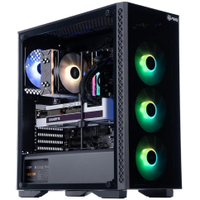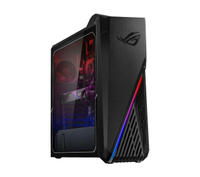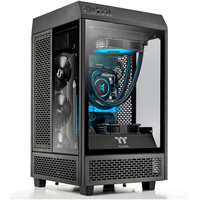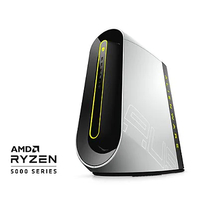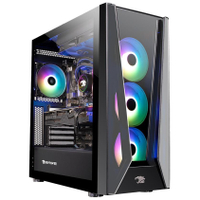Best GeForce RTX 3080 Deals: Where to Find Them
RTX 3080 cards are expensive but you can still find ways to save.

Finding a true GeForce RTX 3080 deal right now — meaning, finding the GPU at a great price — would be rather like finding Bigfoot: Blurry photos and bad costumes aside, neither one exists. The conjunction of the pandemic, increased demand from a variety of sectors, supply chain difficulties, shortages of several key components, and then cryptocurrency mining fever all lined up in such a way as to destroy all hope of finding an RTX 3080 for Nvidia's $699 MSRP.
Outside of periodic small restocks at brick and mortar retailers such as Best Buy or Micro Center, you won’t be able to acquire any of the best graphics cards without paying a big markup. Depending on your definition of a deal, however, you can still find savings. We can't provide absolutely awesome prices, but we can point to some options that are at least worth considering in the current GPU climate.
You might also be interested in our GeForce RTX 3070 deals and GeForce RTX 3060 deals. Those contain similar information and analysis for Nvidia's slightly less expensive GPUs.
RTX 3080 Deals: Quick Links
- Newegg: Up to 15% off RTX 3080 Desktops
- Newegg: RTX 3080 laptops from $1799
- Best Buy: Save $600 on RTX 3080 Ti Desktop
- Alienware: RTX 3080 Ti Desktops from $2699
- eBay: All RTX 3080 cards
ABS Gladiator Gaming PC: was $2,499, now $2,299 at Newegg
This custom-built PC features a Core i7-11700F, GeForce RTX 3080, 16GB of DDR4-3200 RAM and a 1TB M.2 NVMe SSD. That's perfect for running any current game at 1440p ultra settings.
MSI GP66 Leopard: was $2,299, now $1,799 after $100 MIR at Newegg
The MSI GP66 Leopard includes a mobile RTX 3080, Core i7-11800H, 16GB of DDR4 RAM and a 1TB NVMe SSD — all keeping gameplay at its most fluid on the 15.6-inch FHD display with a buttery smooth 240Hz refresh rate.
Asus ROG Strix G156CE Gaming Desktop: $2,999 at Newegg
The lowest price we're currently seeing on a desktop with an RTX 3080 Ti gets you a Core i7-11700KF, 32GB RAM, 1TB SSD, 3TB HDD, and Windows 10 Pro. That's a big jump in price, but this is currently about as fast as GPUs get, basically matching the RTX 3090 in gaming performance.
Three Kinds of RTX 3080
There are actually several graphics cards that can be lumped together under the GeForce RTX 3080 deal banner. Do you want the original GeForce RTX 3080 10GB desktop card, which remains our favorite (theoretical) pick for the best overall graphics card? Or do you want the more recent GeForce RTX 3080 Ti 12GB, which boasts similar performance to the GeForce RTX 3090 but with half the VRAM? Finally, there are laptops sporting the mobile GeForce RTX 3080, which is really more like the desktop RTX 3070, but it's branded as a 3080 — probably because getting a GA102 GPU into a laptop would be difficult at best, considering the desktop cards draw 320W or more power. We'll look at all three options here.
Before we get into how to find RTX 3080 deals, let's set the stage. Our GPU price index tracks recently sold GPUs on eBay. That's not a perfect look at the market, but it does give a reasonable indication of what some people are willing to pay. Not surprisingly, retail prices at places like Amazon and Newegg tend to follow the eBay trends — perhaps minus eBay's 14% pound of flesh, perhaps not. If you can find a GeForce RTX 3080 or GeForce RTX 3080 Ti for several hundred dollars less than the typical eBay price, we'd consider that a "deal" — even if it still ends up being rather expensive.
How Much Does a Standalone GeForce RTX 3080 Cost?
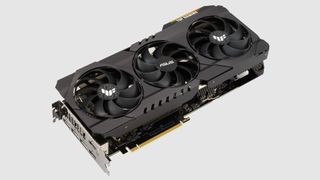
We have a few places we can look for a standalone GeForce RTX 3080. Most vendors charging "reasonable" prices are sold out and have been since the cards launched last year. The easiest place to find an RTX 3080 is eBay, though as usual you'll want to exercise caution — avoid buying from new accounts, and if the price looks too good to be true (basically, anything under $1,000), it probably is. There are tons of scams going on right now, so act accordingly. Beyond eBay, there are third parties selling GPUs on Amazon and Newegg, and there's also the Newegg Shuffle. Here's what we've found looking at current prices.
- Average RTX 3080 eBay Price: $1,739 for sold listings
- Typical Newegg RTX 3080 Price: $1,580 or more
- Typical Amazon RTX 3080 Price: $1,670 or more
- Newegg Shuffle Price: $1,070 to $1,400, more with bundled items
Theoretically, the Newegg Shuffle looks like the best bet, but I can speak from experience and say that out of hundreds of attempts, I have never been selected for an RTX 3080 shuffle — I've only "won" the opportunity to buy an expensive bundle four times, and twice it was for a CPU bundle. The other two times were for an RTX 3080 Ti and RTX 3090 bundle priced at over $2,500. Thanks but no thanks. If you can find a card that's actually in stock, Newegg still might be your best bet, but do note that the typical price for the RTX 3080 is over twice the MSRP in all of the cases we checked.
That takes care of the RTX 3080 10GB cards, but what about the more expensive RTX 3080 Ti 12GB?

- Average RTX 3080 Ti eBay Price: $1,908 for sold listings
- Typical Newegg RTX 3080 Ti Price: $2,007 or more
- Typical Amazon RTX 3080 Ti Price: $2,125 or more
- Newegg Shuffle Price: $1,800 or more, potentially with bundled items
Nvidia "solved" the problem of incredible demand and not enough supply for the RTX 3080 by releasing the RTX 3080 Ti, with a suggested price that was 70% higher for about 10–15% more performance. The result is near-RTX 3090 performance for slightly less money, but the 3090 was really a card designed for graphics professionals. Regardless, the markup on the RTX 3080 Ti tends to be more like 50% rather than more than double, but few gamers should be seriously looking at a graphics card that costs a couple grand.
Interestingly, the going rate on eBay tends to be lower than most of the other options on the RTX 3080 Ti. That's probably because all RTX 3080 Ti cards have Nvidia's hashrate limiter (LHR models), while there are still non-LHR 3080 cards floating around. Miners are willing to pay a premium for the non-LHR cards, driving the average price up. Sellers on Newegg and Amazon meanwhile charge so much that you're already paying scalper prices, so maybe the cards won't just end up being resold on eBay — since tax, shipping, and eBay's cut all need to come out of the sale price.
The bottom line is that if you can find an RTX 3080 for anywhere close to $1,000, that would definitely constitute an "RTX 3080 deal." While the RTX 3080 Ti runs faster, the higher baseline price means you'd be lucky to find one for under $1,500, and that's the sort of RTX 3080 Ti deal we're looking for.
GeForce RTX 3080 Deals in Prebuilt PCs
While it's difficult to find a standalone RTX 3080 deal, large OEMs and system integrators are prioritizing putting graphics cards into complete systems. That's a form of bundling, the idea being that charging a slightly lower premium on the graphics card but selling an entire PC can yield a higher net return. You can find savings on desktops with this GPU at all the major retailers.
The general rule of thumb is that you'll get an RTX 3080, Core i7 or Ryzen 7 CPU (or better), 16GB (or more) of memory, at least 500GB of SSD storage, and of course the motherboard, power supply, and case that make everything work. Pricing starts at about $2,100, with higher spec models going for $2,500 or more.
Considering just the RTX 3080 graphics card would set you back $1,600 or more, buying a complete desktop for another $500 might not be a bad idea. We recently discussed the pros and cons of GPU shucking — buying a prebuilt PC, ripping out the GPU, and then selling off the rest of the system. Some deals are better than others, and we found that in general you'll pay about 50% more than Nvidia's official $700 MSRP for the graphics card, once you subtract the cost of the rest of the system. These days, having only a 50 percent markup counts as a good RTX 3080 deal.
The good news (sort of) is that, often, the more expensive the GPU and PC you choose, the closer the GPU gets to the nominal MSRP. Take the iBuyPower system at Best Buy we’ve listed below as an example, which sells for $2,400. Pricing things out, not including the graphics card you'll pay about $950 for a comparable DIY PC. Factor in another $200 for having the PC pre-assembled and tested, not to mention a legit copy of Windows 10, and that means iBuyPower / Best Buy is "only" charging around $1,250 for the GPU, which would definitely qualify as an RTX 3080 deal. Plus, unlike some big OEMs, it looks as though iBuyPower just uses one of several custom RTX 3080 cards from Asus, Gigabyte, or MSI, any of which would be better than an OEM-only design.
Thermaltake Reactor 380 with Ryzen 7 5800X: was $2,799, now $2,499 at Amazon
This uniquely attractive looking RTX 3080 desktop uses Thermaltake's Tower 100 case to show off its gorgeous RGB innards, 750W 80+ Gold PSU and 120mm Thermaltake AIO. It's powered by a Ryzen 7 5800X, 16GB of RAM and a 1TB NVMe SSD.
ABS Gladiator Gaming PC: was $2,499, now $2,299 at Newegg
Thie custom-built PC features a Core i7-11700F, GeForce RTX 3080, 16GB of DDR4-3200 RAM and a 1TB M.2 NVMe SSD.
iBuyPower Trace MR Gaming Desktop: $2,399 at Best Buy
While there's currently no official sale, this is also a reasonable price for a prebuilt PC with an RTX 3080. You get 16GB RAM, a Core i7-11700KF, 500GB SSD, 1TB HDD, and Windows 11 Home — everything you need for some high-end gaming except a monitor.
GeForce RTX 3080 Ti Deals in Prebuilt PCs
Doing the same for an RTX 3080 Ti bumps the prices up quite a bit, but it also increases some of the other specs as well. You're now looking at around $3,000 as the starting price, for a well-equipped PC with 32GB RAM, a 1TB SSD, and a Core i7-11700KF (or better) processor. The memory and storage upgrades account for about $100 of the price difference, which means you'd still be looking at around $1,750 for just the graphics card (again, putting $200 to assembly and warranty support).
That's steep, but it's not quite as bad as what you'd pay for just the GPU on its own. If you're in the market for a complete PC upgrade — and let's be honest, if you're looking at an RTX 3080 Ti, you better be rocking at least a Core i9-9900K or Ryzen 9 5900X or better — it's likely less of a headache than trying to acquire the parts to build your own PC. It's potentially also less fun, if you're the type of person who enjoys tinkering with their hardware.
Alienware Aurora R10 with RTX 3080 Ti, Ryzen 9 5900: was $3289, now $2699 at Dell
Deal starts at 1 pm ET -- This decked-out Alienware desktop comes equipped with a Ryzen 9 5900 CPU, RTX 3080 Ti graphics, 32GB of RAM and a 1TB SSD.
MSI Aegis RS: was $3,499, now $3,199 at Newegg
MSI's Aegis RS lands with a Core i7-11700K, GeForce RTX 3080 Ti and 32GB of RAM. The gaming PC's storage consists of a 2TB PCIe 3.0 SSD and a 2TB hard drive for secondary storage.
iBUYPOWER Trace5MR1003Ti: was $3,111, now $2,999 at Newegg
This gaming PC is based on Intel's Core i7-11700KF CPU and Nvidia's GeForce RTX 3080 Ti GPU. The other specifications include 16GB of RAM and a 1TB PCIe SSD.
Asus ROG Strix G156CE Gaming Desktop: $2,999 at Newegg
The lowest price we're currently seeing on a desktop with an RTX 3080 Ti gets you a Core i7-11700KF, 32GB RAM, 1TB SSD, 3TB HDD, and Windows 10 Pro. Note that this is a blower 3080 Ti, though — not likely the best cooling solution for a 350W GPU.
GeForce RTX 3080 Laptop Deals
Despite the similarity in name, the mobile GeForce RTX 3080 bears little resemblance to its desktop counterpart. Where the desktop 3080 uses the GA102 GPU with 10GB of GDDR6X memory on a 320-bit memory interface, with 8704 CUDA cores clocked at 1710MHz, the mobile RTX 3080 uses the GA104 GPU with 8GB of GDDR6 memory on a 256-bit interface, and 6144 CUDA cores clocked at up to 1710MHz — but many laptops will limit power and clock speeds, with the minimum boost clock being just 1245MHz. The net result is generally slightly lower performance than the desktop RTX 3070.
But a rose by any other name would smell as sweet, right? It's just a slower, more power-friendly rose that hopefully won't roast your lap. The good news is that prices, for a complete laptop that you can take on the road, or tote to class, end up being pretty comparable to the RTX 3080 desktop PCs. The laptops won't be as fast, but you won't need to add your own display, keyboard, mouse, and speakers — unless you want to.
Specs and other features can vary substantially among laptops, just like with desktops. The lowest price on an RTX 3080 laptop deal we've been able to find right now is the MSI GP66 Leopard at Newegg, normally priced at $1,899 but currently available for $1,799 (after a $100 rebate card, blech). Still, specs are good with a Core i7-11800H CPU, 16GB RAM, a 1TB SSD, and a 1080p 240Hz IPS display. Alternatively, there's a Gigabyte Aorus 15.6-inch at Best Buy, with the same features except it has 32GB memory, for $1,899 and without any rebate shenanigans to deal with.
Asus ROG Zephyrus G15 (Ryzen 9, 16GB): was $2,199, now $1,899 at Best Buy
The ROG Zephyrus G15 comes equipped with a Ryzen 9 5900HS, GeForce RTX 3080 GPU, 16GB of RAM and a 1TB SSD.
Gigabyte Aero 15 OLED YD (Core i7, 4K OLED): was $2,999, now $1,899 at Newegg
Get $1,100 off this stunner of a machine, which uses a 4K Samsung AMOLED panel that covers 100 percent of the DCI-P3 gamut and supports DisplayHDR 400. This system also has a Core i7-11800H CPU, 16GB of RAM and a 1TB SSD. Its RTX 3080 has a boost clock of 1,245 MHz and a maximum graphics power of 105W.
MSI GP66 Leopard: was $2,299, now $1,799 after $100 MIR at Newegg
The MSI GP66 Leopard features the aforementioned mobile RTX 3080 graphics card with 8GB GDDR6 video memory, an Intel Core i7-11800H CPU, 16GB of DDR4 RAM and a 1TB NVMe SSD — all keeping gameplay at its most fluid on the 15.6-inch FHD display with a buttery smooth 240Hz refresh rate.
If you just want to see what’s out there, check our complete list of all the RTX 3080 laptops you can buy. We'll be looking for any other reasonable GeForce RTX 3080 deals during the holiday season and will update this page and our list of the best gaming laptop deals if and when we find them.
If you happen to find something better that we've missed, give us a tip in the comments and we'll add it to the list. Assuming you've already got yours, you'll be helping others to acquire some better gaming goodness this holiday season.
Stay on the Cutting Edge
Join the experts who read Tom's Hardware for the inside track on enthusiast PC tech news — and have for over 25 years. We'll send breaking news and in-depth reviews of CPUs, GPUs, AI, maker hardware and more straight to your inbox.
Jarred Walton is a senior editor at Tom's Hardware focusing on everything GPU. He has been working as a tech journalist since 2004, writing for AnandTech, Maximum PC, and PC Gamer. From the first S3 Virge '3D decelerators' to today's GPUs, Jarred keeps up with all the latest graphics trends and is the one to ask about game performance.
-
VforV Except for the pre-builts this is my answer to all the other so called deals on RTX 3080 = ROLF :ROFLMAO:Reply
Also, even pre-builts are 2x MSRP or more in many places, including EU. -
kinney Gave up on finding NV GPUs for my Intel rigs. Going with Intel Arc for those. Being able to combine IGP compute units with dGPU will be grand.Reply -
JarredWaltonGPU Reply
Nope, not gonna happen. DG2 is going to be about an order of magnitude faster than the integrated Xe Graphics (UHD 770 or whatever), and completely different feature sets. While it might be possible to have the IGP do something lightweight (XeSS perhaps, or video encoding), anything graphically intensive will not work well trying to balance IGP and DGPU. AMD has basically had an opportunity to make dual graphics work well for over a decade, and it never really happened. The best-case result was slow IGP plus slow dGPU = 50-80% improvement in games with driver support for the tech. The problem is that a single dedicated graphics card could easily beat the dual graphics combination.kinney said:Gave up on finding NV GPUs for my Intel rigs. Going with Intel Arc for those. Being able to combine IGP compute units with dGPU will be grand. -
husker Replykinney said:Gave up on finding NV GPUs for my Intel rigs. Going with Intel Arc for those. Being able to combine IGP compute units with dGPU will be grand.
Enlisting a full sized truck and a smart car to pull your boat along the highway together isn't going to end well. -
JarredWaltonGPU Reply
More like a moped. LOLhusker said:Enlisting a full sized truck and a smart car to pull your boat along the highway together isn't going to end well. -
kinney ReplyJarredWaltonGPU said:Nope, not gonna happen. DG2 is going to be about an order of magnitude faster than the integrated Xe Graphics (UHD 770 or whatever), and completely different feature sets. While it might be possible to have the IGP do something lightweight (XeSS perhaps, or video encoding), anything graphically intensive will not work well trying to balance IGP and DGPU. AMD has basically had an opportunity to make dual graphics work well for over a decade, and it never really happened. The best-case result was slow IGP plus slow dGPU = 50-80% improvement in games with driver support for the tech. The problem is that a single dedicated graphics card could easily beat the dual graphics combination.
Care to bet a friendly financial wager on your view that IGP compute units with dGPU won't be combined with Arc on Intel platforms? Reach out via PM, I have $100 US on it.
We'll know soon who is right between the two of us. I have an 11900K and 12900K (latter with no DDR5) and intend to put Arc into my 11900K rig. It's a 720P capable iGPU, which is significant power. I was quoting Intel's CEO BTW. Intel CEO vows to challenge Nvidia, market is "hungry" for alternative GPUs | TechSpot
Pat Gelsinger said:And even better than that, we're going to make integrated and discrete work together. So if you have three worth in the integrated , then you have 10 EUs worth in the discrete, we're going to give you 13 EUs worth, and you're only going to buy 10 EUs worth in the discrete GPU, and you're going to qualify one product that seamlessly between those two." Well, that’s pretty differentiated. And that's just one example.
So for me to be wrong, you're saying the CEO of Intel, an engineer, is a fool that is "not gonna make it happen". You guys can laugh it up all you want, but I'll be taking your money soon. Comparing AMD's efforts to Intel is your second mistake here. It's generous to even mention those two companies in the same sentence, let alone look to AMD on what's possible or will happen at Intel. -
JarredWaltonGPU Reply
I'm not saying he's a fool, I'm saying asymmetrical GPUs configured in any way similar to CrossFire or SLI have never worked out well in practice. There are a few edge cases where you get "perfect" scaling, but most of the time drivers and other stuff gets in the way and you end up with a worse overall experience — microstutter and framerate inconsistencies being the best-case usually. As I note, doing something like XeSS or Quick Sync of some other workload on the secondary iGPU is feasible and might even be interesting. Doing actual real-time 3D graphics rendering where you're trying to split the workload 80/20 or 90/10 ends up being bad, because every frame differs.kinney said:Care to bet a friendly financial wager on your view that IGP compute units with dGPU won't be combined with Arc on Intel platforms? Reach out via PM, I have $100 US on it.
We'll know soon who is right between the two of us. I have an 11900K and 12900K (latter with no DDR5) and intend to put Arc into my 11900K rig. It's a 720P capable iGPU, which is significant power. I was quoting Intel's CEO BTW. Intel CEO vows to challenge Nvidia, market is "hungry" for alternative GPUs | TechSpot
So for me to be wrong, you're saying the CEO of Intel, an engineer, is a fool that is "not gonna make it happen". You guys can laugh it up all you want, but I'll be taking your money soon. Comparing AMD's efforts to Intel is your second mistake here. It's generous to even mention those two companies in the same sentence, let alone look to AMD on what's possible or will happen at Intel.
I would love for Intel to somehow prove AMD and Nvidia wrong. But to be clear, doing compute on both iGPU and dGPU or any other non-3D-gaming workload does not count. EMIB with dual GPUs to get the experience of a single large GPU might work, but that won't be between iGPU and dGPU. Anyway, is that $100 for Intel to just make anything work between iGPU and dGPU? Because if so, yes, I think that will probably happen in some form. But if it's $100 to get universal gaming support with current UHD 770 and Arc GPUs with split-frame rendering balancing the workload and a resulting performance boost that doesn't have a bunch of potential negative side-effects? That is not going to happen and I'd take your bet. XeSS seems the most likely candidate, or some other form of post processing. -
kinney Not sure about all the additional qualifications for a simple bet but regardless a top of the line Arc will have 512EUs and an 11900K has 32EUs. That's potentially a 16% performance boost. Being on the CPU is an advantage over SLI, so I don't know if it's comparable. I'd definitely never use AMD as my example of what's possible with GPUs though. I pretty consider this a fresh start with no precedent, given it's AMD as our precursor for dGPU+iGPU interaction. They can barely get anything working at all. I don't like wasted silicon, and welcome Intel's efforts. We'll see.Reply -
JarredWaltonGPU Reply
Look, Arc will have second generation Xe architecture, UHD 770 has first gen. That right there is enough to create a host of issues for anything more than doing stuff like post processing or XeSS. Intel can try to do more than that, but it will at most end up very limited in both benefit and adoption among games.kinney said:Not sure about all the additional qualifications for a simple bet but regardless a top of the line Arc will have 512EUs and an 11900K has 32EUs. That's potentially a 16% performance boost. Being on the CPU is an advantage over SLI, so I don't know if it's comparable. I'd definitely never use AMD as my example of what's possible with GPUs though. I pretty consider this a fresh start with no precedent, given it's AMD as our precursor for dGPU+iGPU interaction. They can barely get anything working at all. I don't like wasted silicon, and welcome Intel's efforts. We'll see. -
alceryes Reply
The type of dissimilar GPU performance scaling you're referring to is a pipe dream.kinney said:Care to bet a friendly financial wager on your view that IGP compute units with dGPU won't be combined with Arc on Intel platforms? Reach out via PM, I have $100 US on it.
We'll know soon who is right between the two of us. I have an 11900K and 12900K (latter with no DDR5) and intend to put Arc into my 11900K rig. It's a 720P capable iGPU, which is significant power. I was quoting Intel's CEO BTW. Intel CEO vows to challenge Nvidia, market is "hungry" for alternative GPUs | TechSpot
So for me to be wrong, you're saying the CEO of Intel, an engineer, is a fool that is "not gonna make it happen". You guys can laugh it up all you want, but I'll be taking your money soon. Comparing AMD's efforts to Intel is your second mistake here. It's generous to even mention those two companies in the same sentence, let alone look to AMD on what's possible or will happen at Intel.
Edge cases, in datacenters, with very specific data being processed may eventually happen, but in gaming? Not gonna happen for a long while - if ever.
Most Popular







